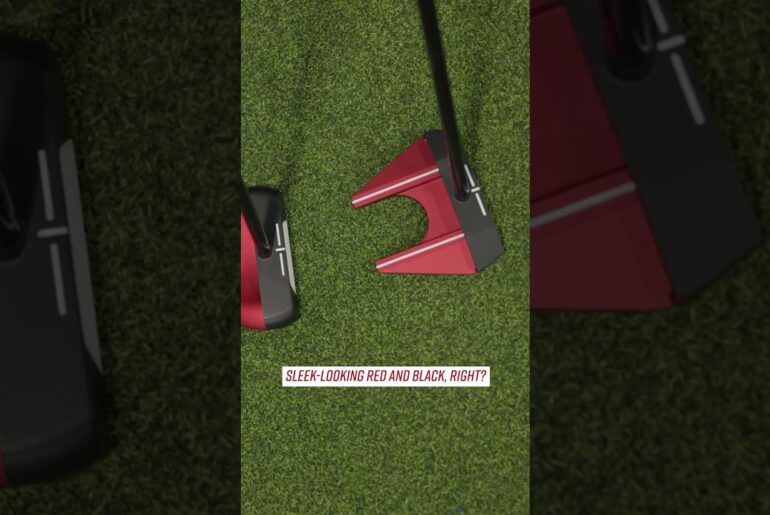It’s one of the coolest shots in golf, The Stinger, but how and why do Tour players hit it. In this episode of Film Study, our very own Luke Kerr-Dineen dives into the low, penetrating ball flight of “The Stinger”.
Comment and let us know what other shots or player swings you’d like to see us break down in a future episode of the series.
Thanks for watching.
Follow GolfDigest:
Instagram / golfdigest
Twitter https://x.com/GolfDigest
Subscribe to Golf Digest on YouTube ►► http://bit.ly/golfdigestyoutubesub
Grab a Golf Digest + membership ►► http://glfdig.st/mFqM50OXuv4
ABOUT GOLF DIGEST
Home of the Hot List, Golf Digest +, news and trends, Golf Digest is the definitive destination for all things golf.
This is perhaps the nastiest short in all of golf. A short so cool that people even gave it its own name. And even that nickname was awesome. Stinger. Stinger. Stinger. That’s right. I’m talking about the stinger. A shot that pros usually use off the tea. It rips through the air like a laser. Very low and usually pretty straight. There are three things that golfers absolutely need to do in order to hit a perfect stinger. I’m going to explain each one along with a shortcut for those who can’t do those three things. That just ran out about 70 80 yards with a low fade. Let’s dive in. If you want to understand how stingers work, maybe because you want to hit one yourself, you really need to understand this right here. This is an illustration of a metric called spin loft, which is a metric first created by Trackman. Spin loft sounds pretty complicated, but it’s actually pretty simple. Spin loft is the difference between the loft of the club at impact and the upwards or downwards direction of your golf swing. If you hit really down on the ball, but have a club with lots of loft, like a wedge, you have a big spin loft around the green, these turn into low launch spinners, like you see Scottish Sheffller hitting right here. Oh, what a shot there. On full swings, these shots start low, then rise, almost ballooning into the air. Slicers tend to have a big spin loft with their longer clubs. Basically, because they swing so steeply into the ball, and that’s what sends the ball up into the air with lots of spin. When you have a low spin loft, but that spin loft is pointing up into the air, you get these shots that I call knuckle bombs. Shots that launch high and fly with a flat trajectory. They’re great off the tea. Rory and Bryson are masters of these knuckle bombs. They’re able to hit their T-shots where they’re actually hitting up on the ball with a lot of speed. It’s pretty much the holy grail of long T-shots because you get that high launch and low spin. Low spin loft means lots of distance. If you’re interested in this kind of shot and you want me to do a future video on them, let me know in the comments below. We actually do listen and we might use your comment to produce the next episode of this series. Anyway, I’m explaining this because for stingers, you need a really low spin loft and you also need these two arrows pointing down more towards the ground. The question of how you do it brings us to the first of the three things that you need. First, you need to hit down on the ball. There are a few ways of doing this, but the easiest way is to just play the ball further back in your stance like you see Tiger Woods doing right here. I like playing a little further back in my stance, maybe a ball ball and a half back in my stance. The reason why this works is because the bottom of every golf swing is shaped like this, a kind of arc. The more you play the ball up in your stance, the more you hit the ball on the upswing. That’s why coaches say to play your driver off your left heel. When you play the ball back, you’re naturally going to hit more down on the ball, which will launch the ball lower and solve half of this spin loft stinger formula. You just need to pair it with the second part. And that second part is shaft lean. When pros hit stingers, they want the ball to start low and then stay low. It’s what makes a good stinger such a weapon in the wind. Putting the ball back and hitting down will definitely help you launch it low. But the problem is is that if you’re hitting, say, two or maybe 3° down on the ball, you need to bring the loft of the club down pretty close to it so that the spin loft is low. Remember, that’s what keeps the ball not just launching low, but flying low. The problem is that there’s no such thing as a negative 3° lofted driver. The lowest lofted club in your bag is usually around 9°. And lots of pros hit stingers with a low lofted iron, like a two iron, which is more like 19°. So, in short, they need to figure out how to deloft these clubs pretty significantly, and they do that with shaft lean. Now, this can get tricky because the way golfers get club head speed is by releasing the club, breaking their hands so that the club head releases aggressively through. But to create more shaft lean and to deloft the club in the process, players often talk about feeling like they’re covering the ball with their body, that they’re releasing more with their body so that their body and hands keep turning while kind of leaving the club head behind. like but I really try and feel like this right shoulder gets on top of that golf ball. Rory Maroy actually talked about exactly this when I asked him about his own driver sting at the open last year. Rory, you’ve hit this shot off the tea a few times this season. This like ultra low drive, you know, like apexes at 30 30 ft 35 ft. I’m just wondering if that’s a skill you’ve always had, if you’ve had to develop it over the years. Yeah. Um it’s definitely something that that’s that I’ve developed more over the years. Uh, and honestly, it’s only a shot I’ve been able to hit since I’ve become a little stronger. Really, it’s it’s about trying to keep my right side um high on the way into the golf ball. This release more with the body than the hands helps golfers deloft the club at impact. And when you add in the third ingredient, it creates those mouthwatering stingers that we all love to look at. And that third thing is speed. In order to hit a really nasty stinger, you need to have speed. It’s what makes these first two elements work. Because if you didn’t have enough speed, the ball simply wouldn’t get off the ground. Here’s an example. Let’s say you hit one of Rory Maroyy’s driver style stingers. Assuming you hit down on the ball about 3° and you lean the shaft forward, so your 10° driver is now like 6° at impact. You’ve got your low launch, low spin loft match that you need. If you hit this drive with 180 mph ball speed, this shot would apex at just 50 ft high, which is less than half the height of Rory’s stock drive. It would carry just shy of 280 and would roll out to about 300 yd on a standard course. But if you hit this exact same shot, but only did it with a standard ball speed of a low singledigit handicapped golfer, something around 150 mph, this drive would peak at just 25 ft and wouldn’t even carry 200 y. When the launch and the spin are this low, horsepower is the only thing that keeps the ball in the air. And when you don’t have it, you don’t have a shot that you can actually use. And generating that ball speed like this is really hard because again, you can’t really release your hands as much as you usually could. You have to rely more on the strength of your body. It’s not a coincidence that the golfers who can hit the nastiest stingers tend to be the ones with a ton of elite upper body strength. It’s why stingers, like the kind pros hit, are fun to watch, but not really that useful or frankly even doable for the rest of us. Most of us just don’t have the ball speed to hit a true stinger like these guys. But the stinger inspired shortcut that lots of coaches suggest is to follow the first two steps. Those being moving the ball back in your stance and leaving the shaft forward. But instead of then trying to generate lots of speed, coaches will often say to do the opposite, to take more club and actually swing softer. In this shot, you still have the bones of a stinger, but the extra club will get the ball just high enough into the air, or the lack of overall ball speed will still keep it low. Done right, this shot will have a more arching flight than a traditional stinger, which flies more like a straight laser. It doesn’t look quite as cool, but it’s a more useful shot for the rest of us. And if nothing else, maybe it’ll give you a little bit more of an appreciation for those pro style stingers the next time you see them on TV. Oh, what a shot. 13 ft apex. Oh, that was saucy. I’ve just got someone near the top of my list for the British Open this year. If he can hit that shot.








46 Comments
Knuckleball – the 1200 rmp drive that absolute craters into the ground 50 yards out. NOT the +300yrd hard hit 14° launch shots.
vid on VSP next #mayo
Yes to both ballooning shots and knuckling shots please
Funny thing about the stinger is I hit a natural stinger with the long irons anyways because I just dont have enough ball speed to get it to balloon like a Rory, Scottie or Tiger would, so they tend to apex at 50 ft anyways.
There's a video on YT if CT Pan demonstrating his "stinger", tee the ball really really low with the driver, swing at 70 speed. I use it here and there, the ball flies 15 feet off the ground, carries 190 and rolls 50 yards, incredible.
Love the content. Going to click on anything Golf Digest. That being said, my favorite videos are ones talking more about course strategy.
Yes, please do a video on the high-launch low-spin drives. Thank you for the videos, very helpful.
Can you please do a video on how pros adjust for wind conditions
need more clips of deshambos
God I can’t get enough of these videos man, so good!! I want to see future videos on the high launch, low spin type of drive too. I want to be waterboarded with this content!
I'd love to see the physics of ball flights for fades, cuts, slices, etc.
Knuckle bomb video please mate 💪
I do that all the time. Usually when I use the driver. It goes about 10 feet off the deck and travels about 150 yards.
Do the knuckleball video too
Low spin high loft shots are the holy grail. Need a breakdown
did this video need to be 8 minutes long though
Of course we want a knuckleball video!
This was incredibly well done.
I hit a beautiful stinger but not on purpose
uhhh…they hit it lower
Can confirm. 7 wood stinger has been mighty playable this year for me.
Yes pls, do a vídeo no that !
I grew up in the valley in California. Lotta Westward win. Learn how to play the stinger early people were so amazed by it. I thought it was easy.
I am a self taught fan of your channel. Please make the video about the nuclear shot. Thank you
Like you show what happens with people without strength, that's all my balls lol
A video on high launch low spin or on "fairway finding" would be great. Love the series, looking forward to whatever is next.
Please do a spin loft video
Too complicated,, take ball bit back in stance ,,,and whack it.
Please I need that video
Do a video of the spin loft and angle of attack
I would be very interested in hearing more on long drive more generally. It's an interesting offshoot of golf and I feel like could be incorporated into the video on knuckleballs.
Yep. There is a reason that lpga players don't play stingers.
Great video awesome illistration. Its really helpful to see how the club face interacts with the ball.
Great. More info in my head while swinging. This freaking game so addicting, yet so hard
Rory says he try’s to keep the right side hi,I try to feel the left shoulder drive through impact .Same shot different swing thought 😅. Great video
Played since 1985 till present
I'm practically off scratch
Me Iv always closed my stance with the ball off centre forward plus closing the face with my hands forward of the ball
My swing is then 3/4 but I drive my hips and right shoulder down when driving through/hitting the ball controlled but with power
completely unorthodox to what pros say
but it works 😊
my advice is find what suits you and works
but most amateurs do this
they look before hitting the ball
Tnx G D , I been practicing these , 3 iron is my easiest to get outcome i want but driver is the 1 I want in the bag of tricks the most.
For sure want a video on the high knuckle ball
Lacking necessary swing speed for a stinger, my old #2 Adams rescue is my go-to club if I need to hit a low, medium distance shot (usually to get under a tree limb!).
MORE
hi christian iooss
Yes 💯 need a video how to hitos spinning drive
I grew up playing golf in west Texas where a calm day was winds 20-30 mph. The "stinger" is just normal golf for us. That's how we all leaned to play and hit our shots. Even irons. Its survival.
Can you do a video about driving and best practices for better tee shots?
Fantastic content again. Thank you. Would love a video on green reading by the pros and how they manage speed.